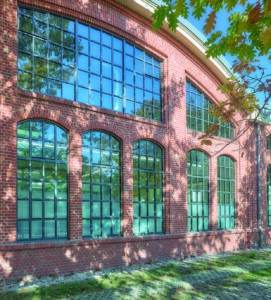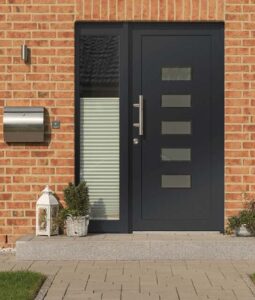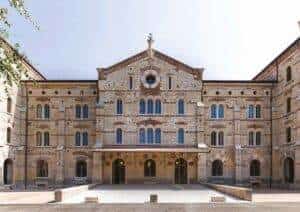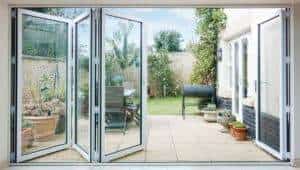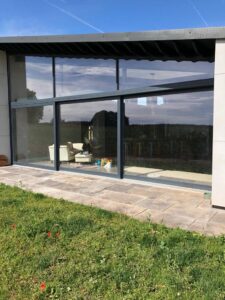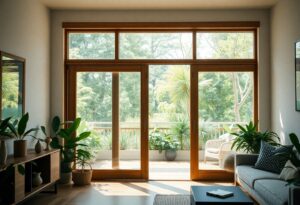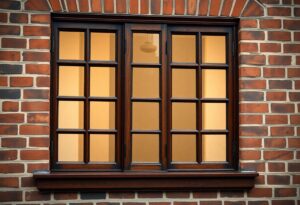Many homeowners face the challenge of choosing the right window material for their property. Each option—Aluminium, uPVC, and Timber—offers unique benefits and drawbacks that can significantly affect your home’s energy efficiency, aesthetic appeal, and maintenance requirements. In this post, we will explore these materials in detail, helping you make an informed decision that aligns with your needs and enhances your living space.

Overview of Window Materials
For homeowners looking to enhance their properties, selecting the right window material is vital. Aluminium, uPVC, and timber offer distinct advantages and drawbacks, influencing your choice based on factors like durability, aesthetics, and maintenance. Understanding these materials will help you make an informed decision that aligns with your needs and preferences.
Aluminium Windows
For those seeking a modern look, aluminium windows may be the ideal solution. Known for their strength and lightweight properties, they offer a sleek design and excellent insulation, ensuring energy efficiency. Their durability means they require very little maintenance, making them a popular choice among contemporary homeowners.
uPVC Windows
Aluminium windows are often compared to uPVC, another popular choice in the market. They are designed to be energy efficient, low maintenance, and affordable, presenting a strong alternative.
Even though uPVC windows are less expensive, they do not compromise on insulation or security. Available in a variety of styles and colours, uPVC can seamlessly match your home’s design. They also resist rotting, warping, and fading, ensuring a long-lasting investment for your property.
Timber Windows
Overview of timber windows reveals their classic appeal, renowned for warmth and character. They provide excellent insulation and aesthetic charm that can enhance the traditional appearance of your home.
Consequently, opting for timber windows requires some consideration regarding maintenance, as they may need regular treatments to prevent rot and decay. However, if well cared for, timber windows can last for decades and can significantly increase your property’s value, providing both comfort and style in equal measure.
Durability and Maintenance
While choosing window materials, durability and maintenance should be a key consideration. Each material varies in resilience against weather, wear and tear, and how much upkeep is needed over time. For a detailed comparison, check out uPVC windows VS wood VS aluminium.
Aluminium
Between the options, aluminium windows stand out due to their high strength and longevity. They can withstand extreme weather conditions without warping or cracking, making them an excellent choice for any climate.
uPVC
Durability is a hallmark of uPVC windows, as they are resistant to rot, corrosion, and fading. This maintenance-free material makes it an ideal option for homeowners looking for longevity without compromising aesthetics.
Plus, maintaining uPVC is straightforward, requiring just a regular wipe-down with soapy water to keep them looking new. Their energy efficiency and ability to withstand harsh elements ensure they remain a dependable choice for years to come.
Timber
Timber windows provide a classic aesthetic but often require more maintenance compared to other materials. You’ll need to regularly check for rot and damage, and they may require repainting or treating over time to maintain their appearance and integrity.
To maximise the lifespan of timber windows, it’s imperative to invest in high-quality treatments and maintenance routines, ensuring they remain an attractive and functional option for your home.
Energy Efficiency
Despite the different materials available, energy efficiency remains a key factor when choosing windows. Each material—aluminium, uPVC, and timber—offers varying levels of insulation and thermal performance, which can significantly impact your home’s energy consumption and comfort. By selecting the right windows, you will not only reduce your energy bills but also contribute to a more sustainable environment.
Thermal Performance
On evaluating thermal performance, you will find that materials affect how heat is retained or lost within your home. uPVC windows tend to excel in this area, providing excellent thermal insulation and keeping your living space cozy in winter whilst ensuring it stays cool during summer. Aluminium windows, although modern and sleek, might require additional insulation to achieve similar efficiency levels.
Insulation Properties
Above all, insulation properties play an integral role in the overall energy efficiency of your home. The materials you choose can either help maintain a stable indoor temperature or allow unwanted drafts.
Understanding the insulation properties of window materials is vital for maximising energy efficiency in your home. uPVC typically offers superior thermal insulation, reducing heat loss and lowering energy costs. In contrast, although timber provides natural insulation benefits, it can be subject to decay if not properly maintained. Meanwhile, aluminium windows can be enhanced with thermal breaks, yet they often require a little more investment upfront. By recognising these factors, you will make a more informed choice that aligns with your energy-saving goals.
Aesthetic Appeal
All window materials have their distinct charm, influencing the overall aesthetic of your property. Material Showdown: uPVC vs. Aluminium vs. Timber Frames explores how aluminium provides a sleek, modern look, while timber offers a classic appeal, and uPVC is versatile enough to mimic both. Your window choice can significantly enhance your home’s personality and complement your architectural style.
Design Versatility
One of the significant benefits of aluminium windows is their ability to be customised into various styles, shapes, and sizes. This flexibility allows you to achieve the perfect look for your home, whether you prefer a contemporary feel or something more traditional. Additionally, uPVC offers a wide range of designs that can suit many different property styles, making it a popular choice among homeowners.
Finish and Color Options
Along with design versatility, the finish and colour options available can greatly influence your decision. With aluminium, you can choose from a plethora of powder-coated finishes, while timber can be painted or stained to match your desired aesthetic. uPVC windows come in numerous colours, allowing you to create a personalised look that fits your home.
Plus, the variety of finish and colour options means you can easily find a combination that resonates with your personal taste. Aluminium boasts long-lasting, fade-resistant coatings, ensuring your windows maintain their appearance over time. Timber gives you the warmth of natural wood and can be re-finished to refresh its look whenever needed. With uPVC, the durability of its colour means less upkeep and consistent looks year after year. Ultimately, the choice of material should enhance your home’s charm while aligning with your maintenance preferences.

Cost Analysis
Now, when considering your options for window materials, the financial aspect is significant. Different materials can influence not just the Window Frames – Aluminium vs uPVC vs Timber – DuCo cost but also long-term savings and maintenance. Understanding the initial investment and long-term value can help you make an informed choice.
Initial Investment
Any window material you choose will come with its own price tag. Generally, aluminium windows require a higher upfront cost, while uPVC tends to be more budget-friendly. Timber can vary significantly based on quality and treatment, often landing somewhere in between. It’s vital to balance your budget with the advantages each material offers.
Long-term Value
One of the most critical aspects to consider is the long-term value of your investment. Each material has its respective lifecycle, energy efficiency, and maintenance costs that will impact your budget.
In fact, when you invest in high-quality aluminium or timber, you are likely to benefit from excellent durability and energy efficiency that can ultimately lower your long-term costs. On the other hand, while uPVC presents a lower initial investment, it may require replacements or repairs sooner, affecting its overall value. Thus, considering these factors can lead you to a more economically sound decision over time.
Environmental Impact
Not all window materials are created equal when it comes to environmental impact. Each option, Aluminium, uPVC, and Timber, has its own footprint that affects sustainability and conservation efforts. Your choice influences not only your immediate surroundings but also the bigger picture of resource use and waste management. It’s imperative to understand these impacts to make an informed decision that aligns with your environmental values.
Sustainability of Materials
Sustainability is a significant factor when choosing window materials. Timber, when sourced responsibly, can be a highly sustainable option as it is a renewable resource that contributes to carbon storage. Aluminium has a longer lifespan but requires energy-intensive production, while uPVC is derived from fossil fuels and is less sustainable in the long run due to its non-renewable origins.
Recycling Potential
Above all, recycling potential plays a vital role in the overall environmental impact of your window choice. Aluminium is highly recyclable and can be reused without losing its properties, making it a responsible choice when considering longevity and waste reduction. In contrast, uPVC is less frequently recycled, often ending up in landfills, while Timber can be reused or repurposed but might not always be as readily available for recycling.
Environmental considerations regarding recycling potential are increasingly important. Your choice of window material should reflect your commitment to minimising waste. Aluminium’s high recyclability ensures it can be reprocessed repeatedly, allowing for a lower environmental footprint. On the other hand, uPVC is often not recycled, contributing to landfill issues and environmental degradation. While Timber can be repurposed, if not sourced sustainably, it may lead to deforestation. Choosing materials with higher recycling potential helps you make a more sustainable choice for your home.
To wrap up
With this in mind, choosing between aluminium, uPVC, and timber for your windows ultimately depends on your specific requirements, budget, and personal preferences. Aluminium offers durability and a sleek aesthetic, uPVC provides excellent insulation and low maintenance, while timber delivers natural beauty and a classic appeal. Consider factors such as energy efficiency, longevity, and visual style before making your decision. By evaluating these elements, you can select the window material that best complements your home and meets your needs.
FAQ
Q: What are the main differences between aluminium, uPVC, and timber windows?
A: The main differences lie in the materials’ properties and aesthetics. Aluminium windows are known for their strength and durability, offering a modern look and minimal maintenance. uPVC windows are cost-effective and energy-efficient, with good insulation, making them a popular choice for residential properties. Timber windows, while traditional and visually appealing, require more maintenance due to their susceptibility to weathering but provide excellent insulation and character.
Q: Which window material offers the best energy efficiency?
A: Generally, uPVC windows tend to offer superior energy efficiency due to their effective insulation properties and multi-chambered frame designs. However, high-quality aluminium windows with thermal break technology can also provide good energy efficiency. Timber windows, while naturally insulating, can vary in performance based on the type of wood and construction methods used.
Q: How do the costs compare between aluminium, uPVC, and timber windows?
A: In terms of initial cost, uPVC windows are typically the most affordable option. Aluminium windows tend to be more expensive due to their durability and modern aesthetics. Timber windows generally fall in the mid to high range, depending on wood type and craftsmanship. Beyond initial costs, it’s vital to consider long-term maintenance expenses, as timber may incur more costs over time compared to the other materials.
Q: What kind of maintenance do these window materials require?
A: Aluminium windows require minimal maintenance, often just an occasional wipe down to keep them clean. uPVC windows also demand very little upkeep, as they resist rot and are easy to clean. Timber windows require regular maintenance, including painting or staining every few years and monitoring for signs of rot or damage, which is vital to prolong their lifespan.
Q: Which material is best for my home style and aesthetic preference?
A: The best material depends on your home’s architectural style and your personal aesthetic preferences. Aluminium windows suit modern and contemporary styles with their sleek profiles. uPVC is versatile and can mimic other materials, making it suitable for various designs. Timber windows offer a classic look and add warmth and character, making them ideal for traditional or period homes. Ultimately, it’s a choice that balances style with functionality.

